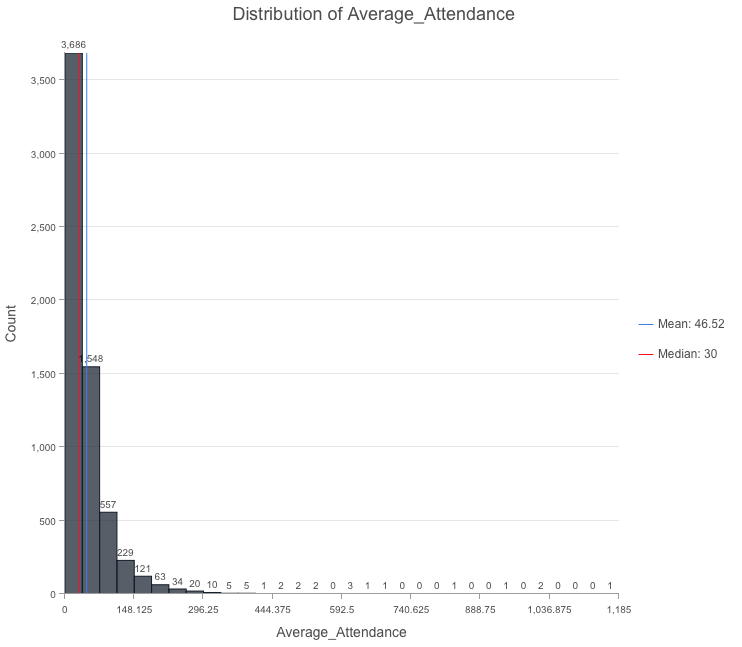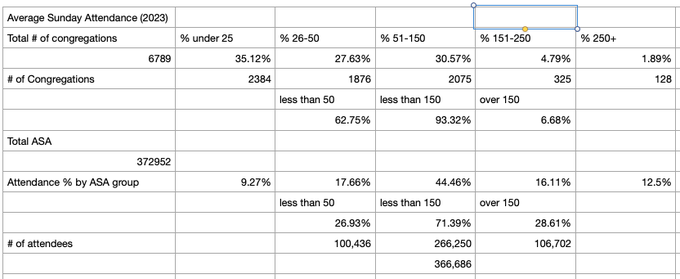Beware this trap.
I’ve been in congregations of varying size, the largest of which was Catholic. The second largest of which was located at the intersection of I-71, I-275, and Fields-Ertel Rd., and sold its property to finance growth. The smallest congregation I was adjacent to was two people. Those two old folks kept the building in tip-top shape until they passed and it was sold–to, of all people, Episcopalians.
If we were to retire all churches with fewer than 50 attendees, we would close more than half, including all in Alaska, though not the two in Micronesia.
If those with fewer than 150, then 93% of all congregations, 71% of all attendees.
The first reason this does not work is that Episcopalians were thin on the ground before they started declining. The decline was coincident with certain changes in practice if not in doctrine, but was presaged by events in other denominations. Some folks might like to blame it entirely on Bishops Pike and Spong; they were accelerants, not a cause.
tl;dr: It’s the Boomers.
The participation rate in church attendance during the middle of the 20th Century was absurdly abnormal. This is due to a couple of reasons, the major ones being not having to work on Sunday, lots of kids, and disorganized sports. We’re dealing with the decline from all of these.

It is no coincidence that the decline in church attendance aligns with the advent of the Rust Belt and the Me Generation’s adolescence, but not for the reasons that all of the fancy people think. It’s only because of 1) economics and 2) adolescence.
In the meantime, the church has been chasing phantoms trying to entice the past three generations of rebellious adolescents to come inside by being cool, and in the process has lost itself. It did not help that earlier in the century most denominations sided with the Modernists.
They became subject to the whims and chances of fate: poll-driven, not unlike the waffler Bill Clinton. So that now they resemble nothing more than another press office for whatever progressive politics cares about this week.
How could that possibly attract anyone, much less cynical youth? They may as well join the Democratic Party or a world-saving, money-grabbing NGO and get their religion from the source.
So, what to do? The parish is critical. Centralization of the physical presence of the church will not work. It will only hasten the decline, for two reasons: 1) it increases the cost of attendance for those who are already attending, and 2) doesn’t address the core problem. It addresses neither doctrine, nor general economic failure, nor the built environment, nor why people move from one place to another. It assumes that we will continue to subsidize large houses and large cars and cheap gas. It assumes congregants have both cash and time.
The middle of the 20th Century was a once-in-a-lifetime event, equivalent to the end of the Black Death in Europe. It has been been obvious for decades that it can’t go on, but we have not changed our behavior one whit.
So what might work? The Rev. Crosby notes an area of expenditure which sucks funds from the work of the church: administrative staff. I’ve not looked at the numbers for the Protestant Episcopal Church of the United States, but the balance in the Church of England is out of whack. Redressing this may entail not being active in random social programs.
One thing which may help local parishes is paying for the livings of clerical staff from the central fund. On the one hand, this would allow distributing staff where needed. On the other, we’re currently in the red due to the assessed contribution to the general fund. See above. Along those lines, one reason clergy need $$ is because of debt. Which brings us to the seminaries. I would prefer they be orthodox, but whether they are or not, postulants should not be saddled with debt and years of waiting before engaging in pastoral work.
Orthodoxy, however, is critical. The Gospel is the reason the Church exists. Without preaching the Gospel, what is the point? Thus, catechesis is as important as evangelism. Teach the people already there. Then spread the news.
All of that is well and good, but we need children. They come back after adolescence, if the church is still there and treated them well. Not all return, but some, perhaps most. And to get children we need to marry men and women. Pragmatic utilitarianism, if the outright injunctions and prescriptions in the Bible won’t, requires that the Church insist that marriages be between men and women and result in children.
Our congregants left. Some have died. Where did they go? Do they play travel soccer on Sunday? Are they working at Walmart? Did they get the hell out of Dodge? If the latter, does that destination have a congregation for them? If it’s a schedule conflict, how can help that? We can, by being ready and waiting, generous and available. But, we do need to realize that barring extraordinarily well-distributed economic prosperity, the church’s natural membership rate is closer to 20% than it is to 60%.
There’s a certain amount of money necessary to keep things afloat. Roofs need repair every now and again. And the congregants do like heat in the winter. And ministers of the Word should be free of worldly care and concern. But income inequality is outside of our direct control: unless of course, one is a believer, a banker, and in a position to effect change. The widow’s mite must sustain us.
The polities of some denominations do not scale as well as others. Some are limited by their view of the sacraments and who can deliver them. Some by what education is required of the minister. Some by who exactly can be ordained. Some are not. It is for these reasons that there are more Baptists and Methodists than there are Presbyterians and Anglicans. And so depending on the denomination there are different logistical considerations which must be taken into account, unless one wants to change one’s polity.
Using statistics to make decisions, rather than simply inform them, can lead one astray. This is true whether one is a church or a Fortune 100 company. Arbitrary cut-offs cause lying.
But more critically, I suppose, they cause one to abandon one’s mission.
I will use Average Sunday Attendance (ASA) <150 as the cutoff in the example below, since there are few congregations between 100 and 150 in average Sunday attendance and I don’t have the full 2022 dataset. See the histogram for 2021 below.


If we were to retire all churches with fewer than 50 attendees, we would close more than half, including all in Alaska, though not the two in Micronesia. If those with fewer than 150, then 93% of all congregations, 71% of all attendees, or 366,686 of the 372,952 who come to church.

Thus very effectively pivoting to video.
Church membership, like almost everything, is a Pareto distribution.
I would like to thank Rev. @benjamindcrosby for starting this discussion. If it were not for thoughtful, concerned clergy like him, this church would stagger blindly over the cliff, wondering all the time why pews were empty while event rental revenue wasn’t making up the slack.
And I would like to thank @iamepiscopalian, because it has offered a refuge for those who have not fled God but who need shelter from the works of men. Though we differ on essential matters, Articles of Religion XXVI still pertains. More theologically, it is not the building but the people who are the church, and where two or three are gathered together, so shall Christ be.

